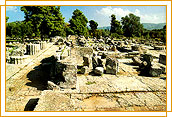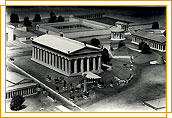Olympia during the 5th century BC
After the Persian Wars, Olympia reached its heyday. The numerous offerings that were found there testify to the large number of participants from all the Greek cities.  Athletes from Sparta and Croton in South Italy dominated the Olympic games in that century. The Greek victory over the Persians enhanced their national consciousness and soon the sanctuary became a symbol of their solidarity. Athletes from Sparta and Croton in South Italy dominated the Olympic games in that century. The Greek victory over the Persians enhanced their national consciousness and soon the sanctuary became a symbol of their solidarity.
In Olympia new secular and devotional buildings were erected. The renowned temple of Zeus and the elaborate statues that were placed in the Altis added prestige to the sanctuary. Built in the middle of the 5th century BC, the temple was the most magnificent monument of the sanctuary, a symbol of the religious and racial bonds between Greeks. It was dedicated to Olympian Zeus and was decorated with movable statues and reliefs. The most well-known cult statue of Antiquity and one of the Seven Wonders of the World stood on the main area of the temple. The gold and ivory statue of Zeus was the work of the sculptor Pheidias and depicted the god as lord of the universe. Zeus sat on a throne, holding a sceptre on his left hand and a Nike on his right one.
During the same period new athletic facilities were erected, such as the Stadium and the Hippodrome. It is the third and last construction stage of the Stadium.  The track was moved 75 meters to the east and it was made by packed earth, while the distance from the stone series of slabs that signified the starting and finishing line was 186 meters. There were no special seats, besides those for the overseers, the official guests and the priestess of Demeter Chamyne, the only woman allowed to attend the Games. The altar of the goddess lay on the north slope of the Stadium, right across the platform of the Hellanodikai. The track was moved 75 meters to the east and it was made by packed earth, while the distance from the stone series of slabs that signified the starting and finishing line was 186 meters. There were no special seats, besides those for the overseers, the official guests and the priestess of Demeter Chamyne, the only woman allowed to attend the Games. The altar of the goddess lay on the north slope of the Stadium, right across the platform of the Hellanodikai.
At the Hippodrome, which occupied an area of about 780 meters at the south of the Stadium, the equestrian contests took place. Two poles were placed on the two edges, and marked correspondingly the starting and finishing line and the point of turn. A stone or wooden wall of 390 meters long, the embolon, divided the main track in two parts. The chariots should ascend from the one side, make a turn and return from the other side, covering thus a distance of 1,200 meters. Even though we do not know the exact number of chariots that participated in a chariot race in Olympia, in the Pythian games, organized at Delphi, ten chariots participated.
The Prytaneion was on the northeast of the site and was built in 470 BC. In the beginning it was small in size, but with the gradual renovations, transformations and later additions it grew in size. There they organized the regular offering of sacrifices at the altars from the Prytaneis, the member of priesthood responsible for the sanctuary. The altar of Hestia was also at the Prytaneion.
|
